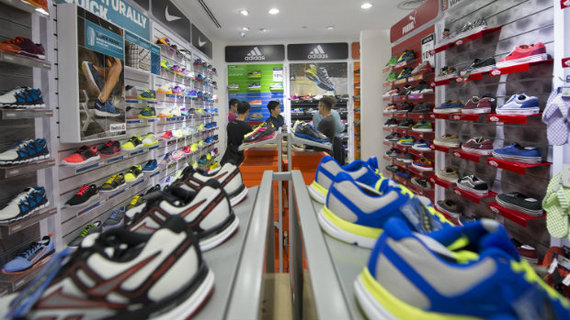By Samuel Blackstone for DETAILS.
Ask any experienced runners and they'll tell you, the most important piece of fitness equipment in their run is the pair of shoes on their feet. Unfortunately, buying the wrong pair of shoes is easier than you think. That's why we've got some tips to ensure your next run ends in glory, not pain.
Buy Your Shoes When You Run
Your feet begin to swell in the morning and don't stop until around four or five in the evening. It's nothing to worry about unless you buy your shoes in the morning, when your feet are their smallest, and run in the evening, when your feet are their largest, or vice versa. The best way to account for your foot's transformation from an eight at eight to a nine at five is to simply try on and buy your sneakers when you will use them most. If you change up your running times a lot, do as the next tip says and "go big."
Go Big
Naturally, your feet move around quite a bit when you run. They swell up, too. Aim for a half to a full thumbnail length between your biggest toe and the end of the shoe. If the fit is too tight, your toes can develop blisters or worse, the dreaded black toenail.
Know Your Gait and Foot Type
You're unique and so are your feet. Having your gait and foot type analyzed at a local running shoe store, or if you're lazy, using something like this, will help ensure you get the feel, fit, cushion, and support you need, and nothing else. In general, the three foot types are flat, neutral, and high arched, all of which determine the level of pronation. Flat-footed runners are prone to overpronation (an inward-rolling motion), and are suited best in a high-stability shoe. Neutral feet are, biomechanically speaking, the best type of feet and can fit well in many types of shoes, but most people with neutral feet like a moderate-stability sneaker. People with high arches are susceptible to underpronation (a outward-rolling motion), and a cushioned shoe with midsole padding and flexibility works best.
Read more: 5 Running-Shoe Myths - Busted
Your Old Shoes Tell a Story
If you're going to a running-shoe store, bring in your old sneakers. If it's a reputable running-shoe store with a good staff (you shouldn't go anywhere else, anyway), they can take a look at your old shoes to get a better understanding of your gait, foot strike, and foot type. Wear patterns on the tread and overstretching on the sides of the shoes can tell them where you land and how your foot moves when you run.
Think Substance, Not Style
It sounds obvious, but choosing a running shoe because of its looks instead of its fit will oftentimes lead you right back to the shoe store a few days later with your shoes, the receipt, and some new blisters. On the other hand, find a shoe with the right fit and maybe you'll be going so fast people won't even be able to see your shoes. Okay, okay, but you get the point.
Don't Be Cheap
As my father used to say, "you only get two feet in this life, take care of them." Don't go with one pair of shoes over another simply because of price. We're not just talking about buying shoes, either. Once you rack up 300 to 400 miles on your sneakers, or once the treads and cushioning seem to be fading, buy another pair. You will prevent injury from the wear and tear on your muscles and joints, and ultimately, save money by preventing a trip to the doctor.
More from DETAILS:
